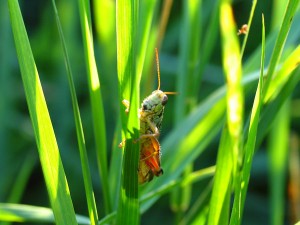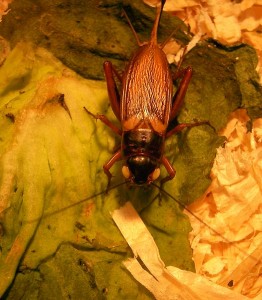When it comes to cricket mating habits, what exactly are these insects looking for in a potential mate? What really makes a male stand out when competing for a female’s attention? Is it his strength, his intellect, his appearance or is it the clarity of his song? A group of researchers at the Karl-Franzens University of Graz have investigated the acoustic component of mate choice in female field crickets (Gryllus bimaculatus), to determine if their natural environment might interfere with the reception of a male’s call.
Male crickets produce a call that is meant to attract females crickets, which is comprised of a series of chirps. When tested in a laboratory, the female responses to a male’s call may differ compared to responses tested in their natural environment. Hence, the researchers tested a group of female crickets in a natural grassland in Graz, Austria, that were exposed to a series of recorded male chirps. The recordings of male chirps differed in their carrier frequency (4.0, 4.4, 4.7, 4.9 or 5.3 kHz) and chirp rate (100, 130, or 150 chirps/min).
The calls were broadcast through a speaker that was positioned 1 cm above the ground in the experimental location. Females were given either a “no-choice” or “two-choice” test upon their release approximately 200 cm away from the speakers, so that they were exposed to recordings coming from either one or two speakers respectively. The researchers recorded the female’s movement towards the speaker using a video camera, measuring the speed of her approach towards the speaker and her overall approach. In the two-choice test, speakers were positioned 180 cm apart, and the female was allowed to move to either of the two speakers, which alternated the two versions of the male song. One featured a high amplitude, and low chirp rate, while the other was low in amplitude, and high in chirp rate.
When tested in a no-choice experiment, all the females approached the speaker. Interestingly, higher temperatures elicited faster approaches toward the speaker. In two-choice trials, females preferred the higher chirp rate, and a frequency of 4.9 kHz. In terms of sound pressure level (SPL), based on the amplitude of the sound, a 5 dB difference was required in the male songs to elicit a statistically significant preference in the female crickets.
It is especially important to note that the difference in amplitude that was required to elicit a preference was higher in outdoor environments than in indoor ones. In laboratory arenas, it only took a difference of 3 dB to determine a preference in females in a two-choice test. Thus, the authors have concluded that indoor environments alter the detection of male cricket song, and are not necessarily representative of natural environments.
Overall, what do these findings imply about cricket song and mate attraction? Essentially, laboratory tests may not be as accurate to natural occurrences as researchers may assume. The presence of background noise can greatly impact the ability of a female to detect a male, which explains why females preferred a louder call outdoors, despite the experimental controls that the researchers established in the field. For the sake of proper scientific investigation, perhaps studies of mate selection in crickets and other insects should be more frequently performed in the field to gain a more accurate understanding of their true mating techniques and selective approaches towards a potential partner.
If you would like to read this article, you can find it on the website for the Journal of Comparative Physiology A.
Hirtenlehner, S. & Römer, H. (2014) Selective phonotaxis of female crickets under natural odor conditions. Journal of Comparative Physiology A, 200 (239-250).



